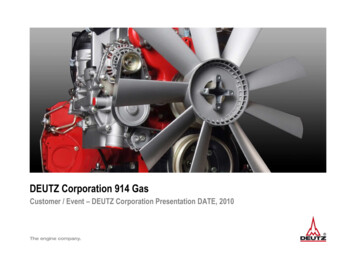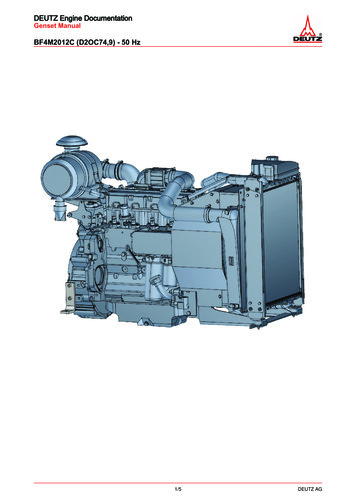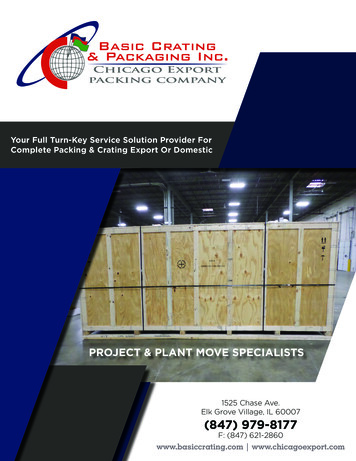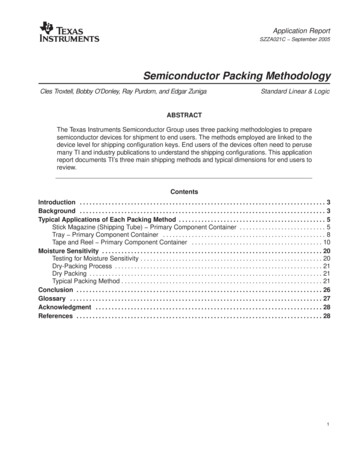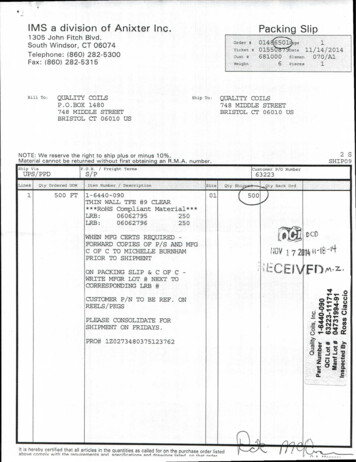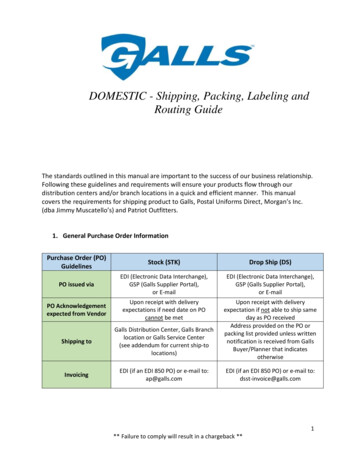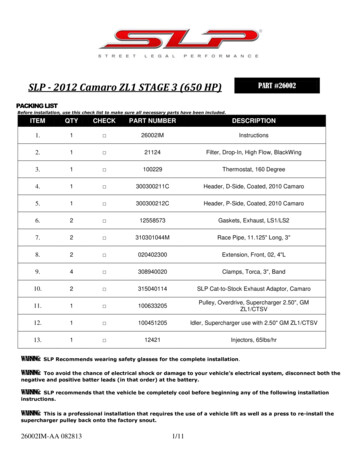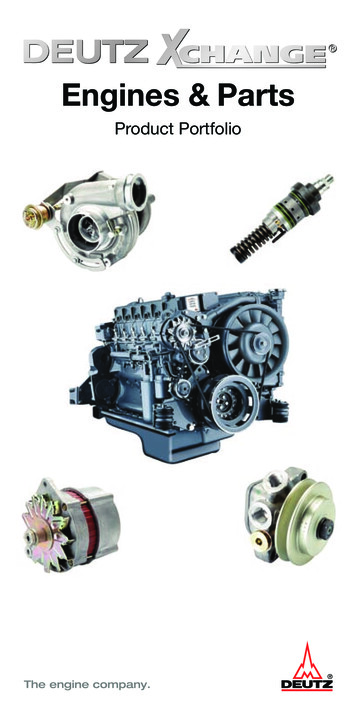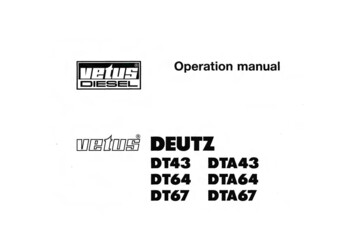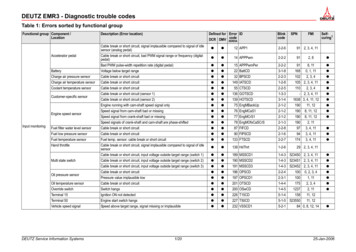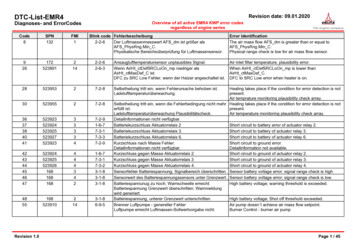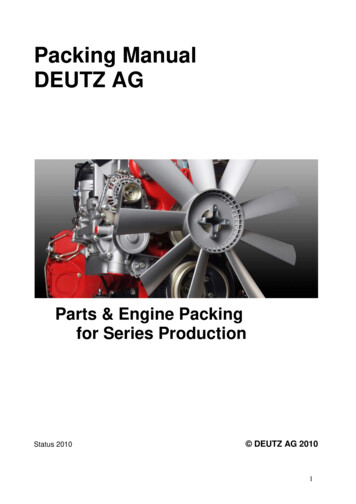
Transcription
Packing ManualDEUTZ AGParts & Engine Packingfor Series ProductionStatus 2010 DEUTZ AG 20101
Table of ContentsIntroductionPacking PlanningIncoming Goods Packing Control34-56-7Reusable Packaging- Principles8- Standard pallet DEUTZ9- Standard container large load carrier (GLT)10- Standard container GLT folding frame11- Standard container for blanks12- Standard container VDA C-KLT13-15- Labelling16-20- Container Ordering21- Cleanliness22-25- Loaned Goods Account Management26Import PackingEngine Packing CBUEngine Packing CKD27-3334-4344-46Appendices- Notes on Corrosion Protection- Overview of DEUTZ Packaging- FAQ- Addresses and Contacts47-5152-6162-6667-69Imprint2702
IntroductionThe Packing Handbook of DEUTZ AG is a reference work for everyone involved withpacking in goods transit: customers, suppliers, incoming goods, warehousing, shippingstations, empty goods stations, forwarding agents.It summarizes all general information that is important for daily work with packaging andproducts in accordance with DEUTZ specifications and which has to be observed.Proper and economical packaging for DEUTZ engine parts and DEUTZ engines is animportant component of the logistics chain. The packaging must correspond to the variousrequirements in respect to quality, production technology, warehousing technology,transport and handling. To this end, the people involved with packing in the variousprocesses continually require information. This information is summarised in the PackingHandbook and can be consulted quickly and easily as and when required.Since the beginning of 1990, Deutz AG has pursued the consistent use of standardisedrecyclable containers and packing systems, supplemented by special packaging that isadapted to the components and engines.For this purpose, DEUTZ has its own specialist department involved with all aspectsconcerning the packing of components and engines.This recognised technical knowledge and the competence of the DEUTZ Packing Planningis presented in a concise way here. The DEUTZ packing will continue to develop in thefuture as well and form an important element of the economical material supply. ThisPacking Handbook will consequently be extended further and updated with the aim ofproviding all technical areas in the logistics chain with the requisite information.Not all detailed information on the relevant packing of components and engines can bedescribed within the context of this Packing Handbook. Further information such asspecifications or handling guidelines, also from other technical departments at DEUTZGlobal Logistics, is available for this.33
Packing PlanningEvery component and end product has relevant packing data at DEUTZ in order toensure an economical material flow corresponding to the requirements of modernlogistics. On this basis the following points are observed:Protection of the productsRetention and improvement of qualityDelivery in line with assembly and productsAssurance of occupational safety, cleanliness and orderCompliance with statutory/official regulationsFulfilment of customer requirementsMinimisation of packing costsUniformity in the workflows over the entire logistics chainTime saving, avoidance of expenseRapid material flowErgonomic handlingClear, simple and rapid informationStandardisationPlanning process:Step 1:Classification of the products according to geometry, value, procurementsources, quantities and quality requirementsStep 2:Selection of the possible packing system taking into account the spatialcircumstances (warehouse, production):- Use of a standard system (e.g. small load carrier)- Development of own containers- Use of standards- Use of existing packing systemsStep 3:Calculation / Profitability calculation with determination of packing type andfilling volume per material, representative for product groupsStep 4:Presentation in the technical departments internally and externally withmeetings and agreements at suppliers, Incoming Goods, Quality Assurance,Warehousing, Production, Purchasing, Materials Scheduling and Controlling.Step 5:Definition of the packing per product with documentation, packingdata in SAP and specificationsStep 6:Information to all areas involvedStep 7:Monitoring the packing44
Packing PlanningPacking system in the area of Incoming Packing and ProductionDefinition of packing specifications- Precise allocation of container type and filling volume per materialaccording to logistic needs (consumption, inventory, capital)- Specifications for the packing of high-quality materials- Standardisation of the labelling (e.g. VDA 4902, AX4, RFID)Monitoring the packing- Admonition procedure and supplier monitoring- Feedback- Material flow (materials scheduling capacity, Kanban)INFORMATIONOptimisation of the material provision- Storage space optimisation, warehouse structure, SYSTEMincoming goods, transport- Storage space optimisation in Production- Material flow (materials scheduling capacity, Kanban)Container management- Exact definition of the container types- Monitoring of empty goods collection points- IT container booking- Container procurement- Container account ingSchedulingOperationalsafetyAuthoritiesPacking system in Shipping CBU / CKDDefinition of packing specifications- Precise allocation of the part or order to the packing typeaccording to specification and customer requirement- Formulation of specifications- Standardisation of the shipping papersMonitoring the packing- Quality of the packing materials- Instruction of the shipping stations- FeedbackOptimisation of the shipping- Order preview- Optimisation of the material provision- Workflow optimisationINFORMATIONSYSTEMPacking material procurement- Processing the orders- Selecting suitable materials- Cost ngSafetyAuthorities
Incoming Goods Packing ControlThe logistics systems of the DEUTZ AG plants are designed in respect to a specified,standardised packing for an optimal material flow in the area of warehousing, assemblyand transport. Each individual part for production and assembly is linked to a packingspecification. The defined packing specifications are coordinated to the part geometry,quality and consumption quantities and are communicated to the suppliers in the ordersand packing data sheets.Compliance with the packing specifications is a prerequisite for a smooth flow of materialsfrom the supply to the installed engine. If the material flow is disrupted, this will lead toextra expense or quality losses.Incoming Goods receives material and forwards it to the warehouse, from where it isissued to Assembly and Production in line with needs.The material should therefore be packed in Incoming Goods, before putting into storage,in accordance with the standard ( packing specification). If this is not the case, extraexpense will result due to e.g. label printing, counting, weighing, rejection and repackingwork.Workflow of the packing controlOrdersThe supplier receives the packing specifications for the ordered part with the relevantframework agreements and individual orders. The required empty containers should beordered from DEUTZ 14 days before needed and sent by the responsible regionalforwarding agent.Receipt of goodsThe driver of the forwarding company will hand over the freight papers to the IncomingGoods office. The material access is then booked with SAP. The goods receipt certificateand containers labels are created by this. An employee at Incoming Goods will then checkthe delivery based on the packing specification marked on the labels and goods receiptcertificate and characterise the goods receipt according to a 10-point catalogue. Thepapers are then given to the Incoming Goods office for processing. In the second goodsreceipt stage, container and packing data as well as the classification of the packagingused are booked.ProcessingThe incoming goods evaluation is checked on a daily basis. In the case of complaintrelevant evaluations, a complaint letter (mail or fax) for the shipping is printed out. Thecheck in respect to the plausibility of the data for the incoming goods is performed daily. Ifthe complaint concerning the incoming goods is not justified, it is neutralised in SAP byindicating the reason for the deletion. Deleted admonitions are saved for statisticalpurposes.Send complaints remain in SAP for 14 days in order to check objections by the suppliers.The complaint can be neutralised within a 14 day period if the supplier objections arejustified.After 14 days without complaint or objection, the supplier will be charged 40 per repackedtransport unit in order to cover the expense for extended administration and repacking.66
Incoming Goods Packing ControlNoteThe packing control and potential complaints do not serve the purpose of encumberingsuppliers. Faults and defects leading to an inadequate delivery are to be revealedby the control and direct information.Graphic representation of the workflowPacking planningCompiling the packing instructions1Ordering96Charging the costs for repacking in caseof supplier defectsPackinginstructionsChecking the complaint,Release of the complaintIncoming goods2InformationPacking inspection4Packging3SupplierTransport5Complaint after defect87Sending the complaintStatement of opinion by supplier77
Reusable PackagingPrinciples for the use of reusable packaging:Environment protection is promoted by less packaging waste and rawmaterial resources are conserved on more sustainable basisThe statutory requirements (Packing Ordinance) are satisfied through the use ofreusable packagingSecure transport containers support health and safety at workThere is less waste in the companies without disposable packaging and it istherefore cleaner at all areasMaterials are protected by the reusable packaging and hence the quality isimprovedThe handling is simplified, saving valuable work timePacking costs for the parts procurement are lowReusable containers are control elements in the assembly and materials schedulingcompliant material supplyDEUTZ reusable containers are valuable and must be treated with careCustomers and suppliers of DEUTZ AG are supplied with reusable packaging fortransport purposes in line with materials and needs. The use of DEUTZ recyclablecontainers for company-internal use or storage is not permittedThe basis for a secure and production compliant delivery is a functioning system ofcontainer supplyNote:Deliveries with materials packed with EURO pallets or EURO mesh boxes have no longerbeen permitted at DEUTZ AG since January 2009. Incoming Euro pallets/mesh boxesmust be replaced 1:1 at the Incoming Goods on the same day, a later exchange is notpossible. DEUTZ AG will not reimburse replacement fees for EURO empty containers.Please only use DEUTZ’ own pallets (P1X) or containers (K1, C3E5, PCB1) as indicated inthe Deutz packing instructions.EUR8EPAL8
Reusable PackagingStandard pallet DEUTZ P1XIdentification with DEUTZ logoand IPPC stampPallet blocks riveted99
Reusable PackagingStandard container large load carrier (GLT)DEUTZ K1 (wood)DimensionsOuter120x78x89 cmInner118x78x73 cmWeight 39 kgLoad max800kgDEUTZ C3E5 (steel)DimensionsOuter120x78x97 cmInner 109x78x76cmWeight 110 kgLoad max.1000kgStandard intermediate layers (special workpiece carriers as per Packing Specification,on request)ZW1302 plastic hollow cavity pallet10ZW1280 wood ZW1281 plastic10
Reusable PackagingStandard container large load carrier folding frame systemDEUTZ P1X pallets with folding frame (foldable in the middle)Cover PB44Frame PCB1Min. 1 frame2 framesPallet P1X3 framesFrame dimensionsOuter :1200x800x200 mmInner1140x750x200 mmWeight 9 kgLoad max.800kg11Max. 4 frames highMatching base and intermediate layerZW1299 1130x745x6 mm plywoodCover PB44 made from ABS plastic11
Recusable PackagingContainer for raw partsDEUTZ CA2DimensionsOuter100x80x70cmInner 99x79x60cmWeight 70 kgLoad max.1200kgDEUTZ CB3DimensionsOuter120x100x70 cmInner 116x96x60cmWeight 100 kgLoad max.1200kgDEUTZ CA3DimensionsOuter100x80x70 cmInner 96x76x60cmWeight 82 kgLoad max.1200kg1212
Reusable PackagingStandard container VDA C-KLTKLT43 .KLT 4314, 40x30x14 cm (334x247x103mm)KLT 4 321,40x30x21cm (334x247x169mm)KLT 4328, 40x30x28cm (334x247x236mm)KL43 coverZW4331 intermediate layerKLT64.KLT 6414, 60x40x14 cm (532x346x98mm)KLT 6421, 60x40x21cm (532x346x164mm)KLT 6428, 60x40x28cm (532x346x231mm)KL64 coverZW6431 intermediate layerSmall load carrier stack onP1X pallet with KLT4314Securing and coveringplate for palletSP1218 / A1218The use of R-KLT is possible, RL-KLT cannot be used.Workpiece carriers as per packing instructions available on request1313
Reusable PackagingStandard container KLT (small load carrier)Label position & stacking1. KLT 43KLT4314 four layers max., KLT4321 three layers max., KLT4328 two layers max.insert labelsDeutz TN 0867 08152000 itemsDeutz TN 0867 08152000 itemsDeutz TN 0867 08152000 items8001200Labelholder 400mm side2. KLT 64.KLT6414 six layers max., KLT6421 four layers max., KLT6428 three layers max.insert labelsLabel holder400mm side80012001414
Recyclable PackagingStandard container KLT (small load carrier)Shipping with mixed small load carrier pallets, example:Deliverynote1Part no.04254711Deliverynote2Part no. 04174713Deliverynote3Part no.02234712KLT stacked on o n e palletFr.letter Deliverynote1-3Small load carriers with the most number of articles in the lower most small load carrierlayer, further small load carriers stacked by number. Fill up potential gaps in the small loadcarrier with empty small load carriers to be able to put on the covering plate.Every small load carrier on the mixed pallet must be identified with an individual label inorder to avoid mixing up parts.1515
Reusable PackagingStandard container large load carrier (GL
products in accordance with DEUTZ specifications and which has to be observed. Proper and economical packaging for DEUTZ engine parts and DEUTZ engines is an important component of the logistics chain. The packaging must correspond to the various requirements in respect to quality, production technology, warehousing technology,
